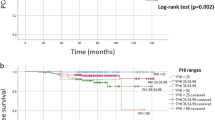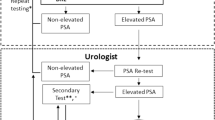Abstract
Background:
To evaluate whether the presence of both prostate atrophy (PA) and chronic prostate inflammation (CPI) in the same biopsy and in the same biopsy core are associated with prostate cancer (PCa) risk and grade in repeat biopsies.
Methods:
Retrospective analyses of 6132 men who were 50–75 years old undergoing 2-year repeat prostate biopsy after a negative baseline biopsy for PCa in the REduction by DUtasteride of prostate Cancer Events (REDUCE) study. PA, CPI and PCa were determined by central pathology. The association of baseline PA and CPI with 2-year repeat biopsy cancer status and grade was evaluated with χ2 test and logistic regression controlling clinicopathological features.
Results:
PA, CPI and both were detected in 583 (9.5%), 1063 (17.4%) and 3675 (59.9%) baseline biopsies, respectively. Compared with biopsies with neither PA nor CPI, the presence of PA (odds ratio (OR)=0.73, 95% confidence interval (CI)=0.57–0.93), CPI (OR=0.72, 95% CI=0.58–0.88) and both (OR=0.54, 95% CI=0.45–0.64) were associated with lower PCa risk in the 2-year repeat prostate biopsy. Results were similar in multivariable analysis. Among subjects with both PA and CPI, those with both findings in the same core had even lower PCa risk compared with PA and CPI in different cores (univariable OR=0.68, 95% CI=0.51–0.91; multivariable OR=0.73, 95% CI=0.54–0.99). Combination of PA and CPI was associated with lower risk of high-grade PCa.
Conclusions:
The presence of both PA and CPI in baseline biopsies, especially in the same core, was associated with lower PCa risk and grade. The presence and topographical distribution of PA and CPI may be used in PCa risk stratification.
This is a preview of subscription content, access via your institution
Access options
Subscribe to this journal
Receive 4 print issues and online access
$259.00 per year
only $64.75 per issue
Buy this article
- Purchase on Springer Link
- Instant access to full article PDF
Prices may be subject to local taxes which are calculated during checkout
Similar content being viewed by others
References
Moore CK, Karikehalli S, Nazeer T, Fisher HA, Kaufman RP Jr, Mian BM . Prognostic significance of high grade prostatic intraepithelial neoplasia and atypical small acinar proliferation in the contemporary era. J Urol 2005; 173: 70–72.
Moreira DM, Nickel JC, Gerber L, Muller RL, Andriole GL, Castro-Santamaria R et al. Baseline prostate inflammation is associated with a reduced risk of prostate cancer in men undergoing repeat prostate biopsy: results from the REDUCE study. Cancer 2014; 120: 190–196.
Moreira DM, Nickel JC, Andriole GL, Castro-Santamaria R, Freedland SJ . Chronic baseline prostate inflammation is associated with lower tumor volume in men with prostate cancer on repeat biopsy: results from the REDUCE study. Prostate 2015; 75: 1492–1498.
Moreira DM, Nickel JC, Andriole GL, Castro-Santamaria R, Freedland SJ . Greater extent of prostate inflammation in negative biopsies is associated with lower risk of prostate cancer on repeat biopsy: results from the REDUCE study. Prostate Cancer Prostatic Dis 2016; 19: 180–184.
Moreira DM, Bostwick DG, Andriole GL, Peterson BL, Cohen HJ, Castro-Santamaria R et al. Baseline prostate atrophy is associated with reduced risk of prostate cancer in men undergoing repeat prostate biopsy. J Urol 2015; 194: 1241–1246.
Servian P, Celma A, Planas J, Placer J, de Torres IM, Olivan M et al. Clinical significance of proliferative inflammatory atrophy finding in prostatic biopsies. Prostate 2015; 75: 1669–1675.
Andriole GL, Bostwick DG, Brawley OW, Gomella LG, Marberger M, Montorsi F et al. Effect of dutasteride on the risk of prostate cancer. N Engl J Med 2010; 362: 1192–1202.
Abrahams NA, Bostwick DG, Ormsby AH, Qian J, Brainard JA . Distinguishing atrophy and high-grade prostatic intraepithelial neoplasia from prostatic adenocarcinoma with and without previous adjuvant hormone therapy with the aid of cytokeratin 5/6. Am J Clin Pathol 2003; 120: 368–376.
Nickel JC, Roehrborn CG, O'Leary MP, Bostwick DG, Somerville MC, Rittmaster RS . Examination of the relationship between symptoms of prostatitis and histological inflammation: baseline data from the REDUCE chemoprevention trial. J Urol 2007; 178: 896–900.
Wu C, Moreira DM, Gerber L, Rittmaster RS, Andriole GL, Freedland SJ . Diabetes and prostate cancer risk in the REDUCE trial. Prostate Cancer Prostatic Dis 2011; 14: 326–331.
Berney DM, Algaba F, Camparo P, Comperat E, Griffiths D, Kristiansen G et al. Variation in reporting of cancer extent and benign histology in prostate biopsies among European pathologists. Virchows Arch 2014; 464: 583–587.
Schatteman PH, Hoekx L, Wyndaele JJ, Jeuris W, Van Marck E . Inflammation in prostate biopsies of men without prostatic malignancy or clinical prostatitis: correlation with total serum PSA and PSA density. Eur Urol 2000; 37: 404–412.
Zlotta AR, Egawa S, Pushkar D, Govorov A, Kimura T, Kido M et al. Prevalence of inflammation and benign prostatic hyperplasia on autopsy in Asian and Caucasian men. Eur Urol 2014; 66: 619–622.
Delongchamps NB, de la Roza G, Chandan V, Jones R, Sunheimer R, Threatte G et al. Evaluation of prostatitis in autopsied prostates—is chronic inflammation more associated with benign prostatic hyperplasia or cancer? J Urol 2008; 179: 1736–1740.
Postma R, Schroder FH, van der Kwast TH . Atrophy in prostate needle biopsy cores and its relationship to prostate cancer incidence in screened men. Urology 2005; 65: 745–749.
Porcaro AB, Novella G, Molinari A, Terrin A, Minja A, De Marco V et al. Prostate volume index and chronic inflammation of the prostate type IV with respect to the risk of prostate cancer. Urol Int 2015; 94: 270–285.
Yun BH, Hwang EC, Yu HS, Chung H, Kim SO, Jung SI et al. Is histological prostate inflammation in an initial prostate biopsy a predictor of prostate cancer on repeat biopsy? Int Urol Nephrol 2015; 47: 1251–1257.
Brasil AA, Favaro WJ, Cagnon VH, Ferreira U, Billis A . Atrophy in specimens of radical prostatectomy: is there topographic relation to high-grade prostatic intraepithelial neoplasia or cancer? Int Urol Nephrol 2011; 43: 397–403.
Billis A, Magna LA . Inflammatory atrophy of the prostate. Prevalence and significance. Arch Pathol Lab Med 2003; 127: 840–844.
Iczkowski KA, Torkko KC, Wilson RS, Lucia MS, Bostwick DG . Prostatic atrophy: its spatial proximity to carcinoma and intraepithelial neoplasia based on annotation of digital slides. Hum Pathol 2014; 45: 54–58.
De Marzo AM, Platz EA, Epstein JI, Ali T, Billis A, Chan TY et al. A working group classification of focal prostate atrophy lesions. Am J Surg Pathol 2006; 30: 1281–1291.
Wang W, Bergh A, Damber JE . Morphological transition of proliferative inflammatory atrophy to high-grade intraepithelial neoplasia and cancer in human prostate. Prostate 2009; 69: 1378–1386.
Van Leenders GJ, Gage WR, Hicks JL, van Balken B, Aalders TW, Schalken JA et al. Intermediate cells in human prostate epithelium are enriched in proliferative inflammatory atrophy. Am J Pathol 2003; 162: 1529–1537.
Celma A, Servián P, Planas J, Placer J, Quilez MT, Arbós MA et al. Clinical significance of proliferative inflammatory atrophy in prostate biopsy. Acta Urol Esp 2014; 38: 122–126.
Servian P, Celma A, Planas J, Placer J, de Torres IM, Morote J . Clinical significance of proliferative inflammatory atrophy in negative prostatic biopsies. Prostate 2016; 76: 1501–1506.
Al-Azab R, Toi A, Lockwood G, Kulkarni GS, Fleshner N . Prostate volume is strongest predictor of cancer diagnosis at transrectal ultrasound-guided prostate biopsy with prostate-specific antigen values between 2.0 and 9.0 ng/mL. Urology 2007; 69: 103–107.
Freitas DM, Andriole GL, Castro-Santamaria R, Freedland SJ, Moreira DM . Extent of baseline prostate atrophy is associated with lower incidence of low- and high-grade prostate cancer on repeat biopsy. Urology 2016; 103: 161–166.
Acknowledgements
Data were provided by GSK. No funding was provided for this study.
Author information
Authors and Affiliations
Corresponding author
Ethics declarations
Competing interests
I certify that all conflicts of interest, including specific financial interests and relationships and affiliations relevant to the subject matter or materials discussed in the manuscript (eg, employment/ affiliation, grants or funding, consultancies, honoraria, stock ownership or options, expert testimony, royalties, or patents filed, received or pending) are the following: DdOF, JCN and DMM have no disclosures; GLA Jr: consulting and advisory board (GlaxoSmithKline, PLC), speaker fees (GlaxoSmithKline, PLC), research support (GlaxoSmithKline, PLC); RC-S: employee (GlaxoSmithKline, PLC); SF: research support (GlaxoSmithKline, PLC)
.
Additional information
Supplementary Information accompanies the paper on the Prostate Cancer and Prostatic Diseases website
Rights and permissions
About this article
Cite this article
Moreira, D., de O Freitas, D., Nickel, J. et al. The combination of histological prostate atrophy and inflammation is associated with lower risk of prostate cancer in biopsy specimens. Prostate Cancer Prostatic Dis 20, 413–417 (2017). https://doi.org/10.1038/pcan.2017.30
Received:
Revised:
Accepted:
Published:
Issue Date:
DOI: https://doi.org/10.1038/pcan.2017.30
This article is cited by
-
External validation of Cormio nomogram for predicting all prostate cancers and clinically significant prostate cancers
World Journal of Urology (2020)



